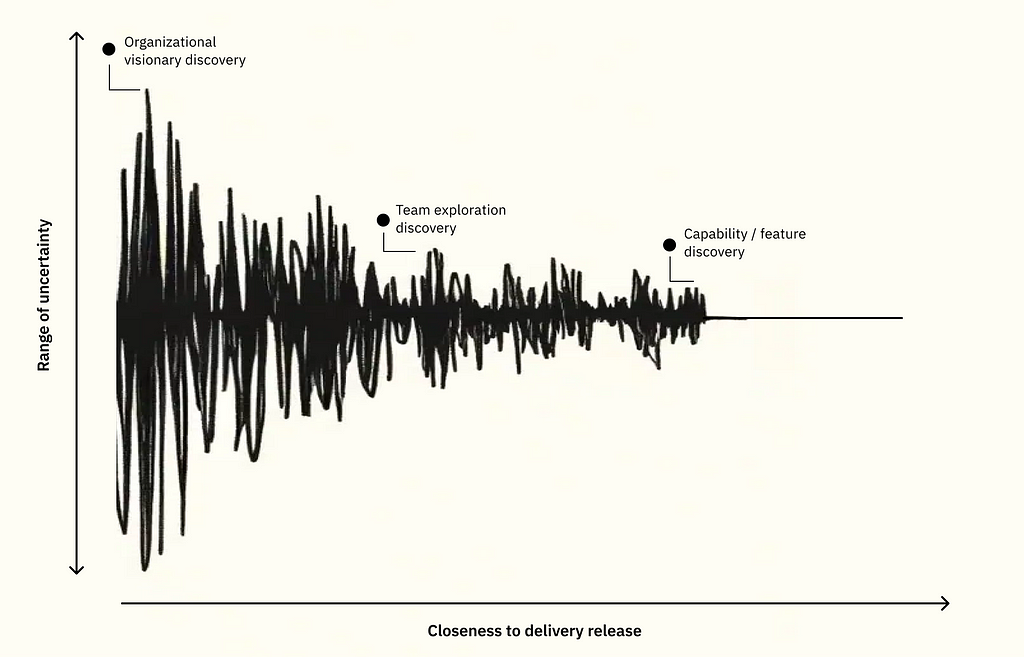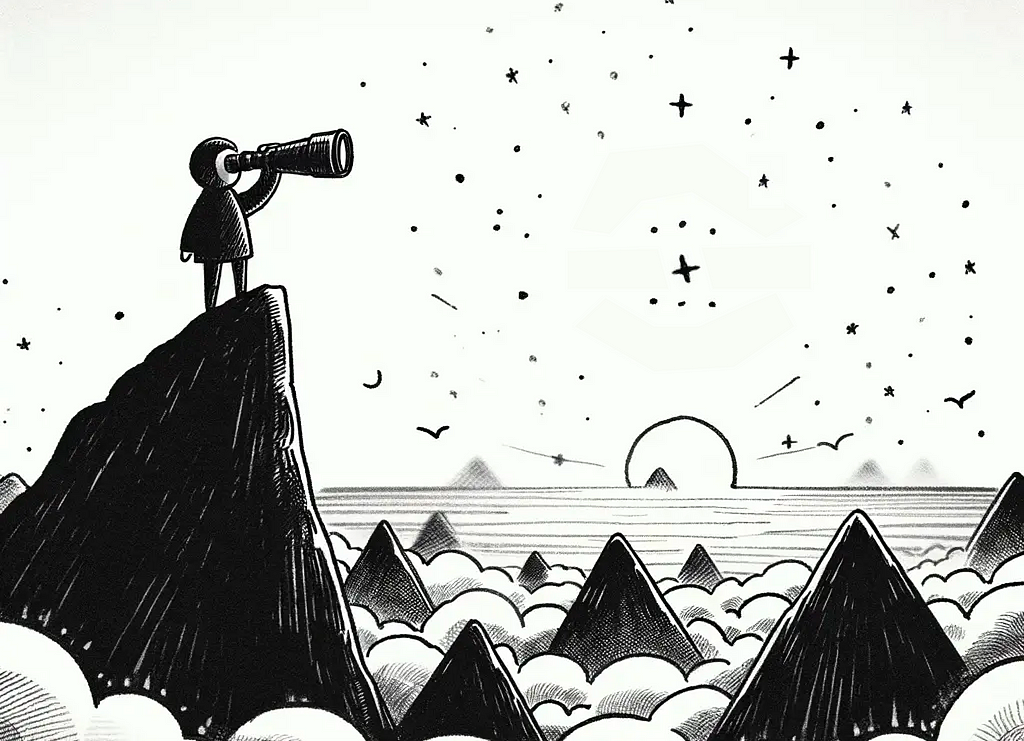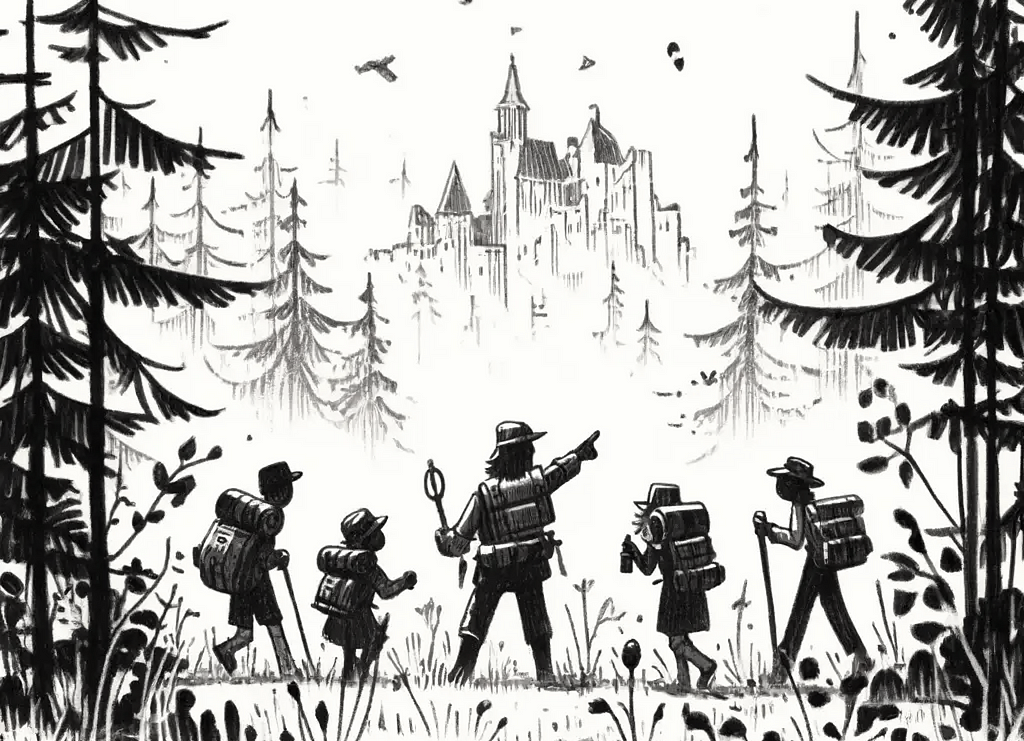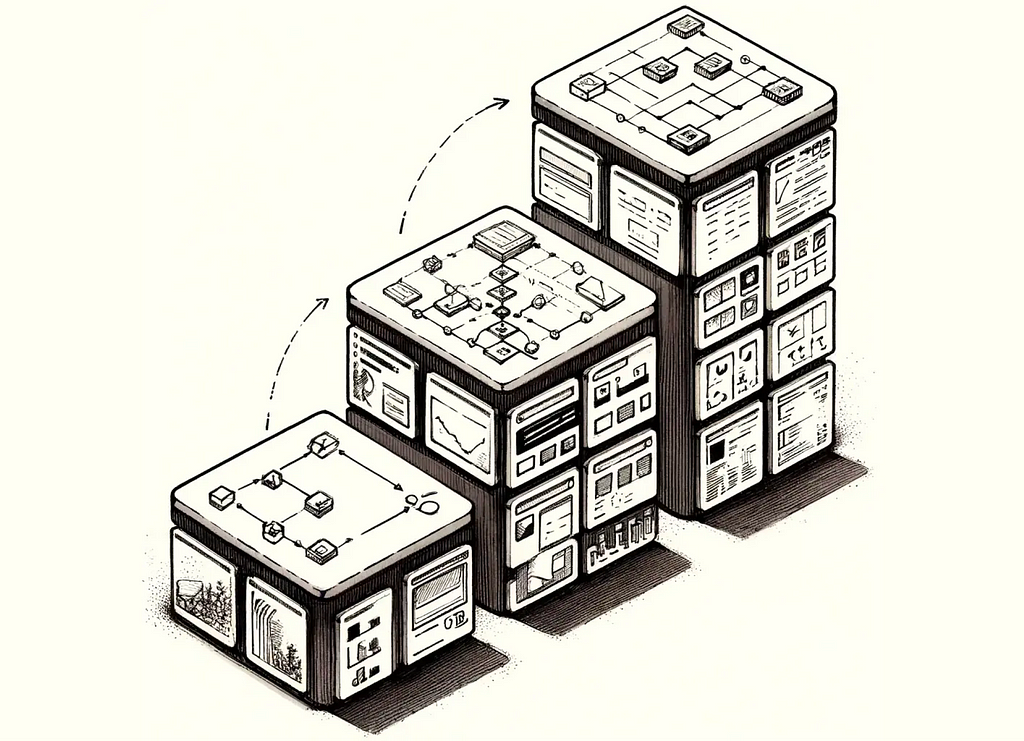What does understanding cultural needs mean for experience success?
The inherent correlation between scope of impact, and level of uncertainty.
What is “discovery”?
In large scale organizations with a healthy design function, ‘discovery’ is often described as the practice of informing the business through exploratory (usually research) work — a concept popularized by folks like the great Marty Cagan. Unlike its counterpart, delivery, which focuses on executing and bringing designs to market, discovery involves a preparatory phase. It’s akin to target shooting: assessing the environment, calculating distances, and making adjustments before taking the shot.
The challenge of defining discovery
Discovery encompasses a wide array of activities, making it a nebulous term, especially in medium to large enterprises. From exploring new markets like generative AI or sustainability, or even reviewing if you should be restructuring swathes of your product portfolio, to refining specific feature requirements best ‘bang for the buck’, the scope of what people consider ‘discovery’ is often so vast and varied that usage of the term might not actually give any of us a better idea of what you’re actually doing.
Operationalizing discovery
To truly excel in discovery, organizations must develop a rubric for classifying and managing them. I’m here to argue that the most effective way to do this is to use the type of questions discovery is trying to answer as the guiding principle for this categorization and subsequent project design.

Classifying discovery projects
Discovery projects can generally be divided into three categories, each with distinct objectives and scopes. Let’s go through them at a high level now.
Tip: If you’re not certain which scope fits the discovery request or idea you’re seeing, I suggest the sponsor asking for the project completes an assessment of the products opportunity, which will give you and the team more to go off of when making the call.
1. Vision: Organizational discovery
Enable strategic decisions on pursuing new opportunities with a clear narrative.

Vision discovery tackles high-level strategic questions about entering new markets or making significant changes within your organization. It’s about setting the stage for major initiatives and deciding whether and how to pursue emerging opportunities, aiming to create a validated user experience narrative that informs go/no-go decisions at the executive level.
What this looks like:
- Uncertainty Level: High
- Outcome scope: Potentially affects multiple teams and releases.
- Prioritization: When possible, this should be part of a separate opportunity list maintained by the executive function for an organization using a standardized brief template. These items will almost never beat out the day to day priorities, so need to be prioritized and resourced (see below) separately for success. Otherwise, you’ll find them forever sitting in the backlog.
- Project management: Each brief should outline the needs and expected deliverables for a project in this space. As such, once a proposed project reaches a level of maturity, a project plan should be put together by the vision owner that will outline how it should best be run, and what timelines are desired.
- Resourcing: Due to this type of visioning being outside of the regular priority/resourcing framework of your organization, here’s where things get fun. You’re going to need to look for 1–3 cross functional senior ICs as you can get. If you happen to have a shadow strategy board, or super senior ICs — now is the time to steal them for a time boxed project. If not, your options are to look externally (using your brief to land an agency).
- Typical activities: User & market research, competitor analysis, lo-fi designs and pitch-deck style storyboarding.
- Follow-up: Level 2 and 3 discovery projects. Delivery tactics and team assignments.
If there’s something brewing that needs to be figured out but would impact the very structure of how your organization delivers value to users through products with no one clear team that would ‘own it’, then this is the space you’re playing in! Post vision, you’ll all know why you’re here and what a north star of success might look like.
2. Exploration: Team discovery
Clarify and align a team understanding on approach and delivery of specific capabilities.

Exploration focuses on the things that present uncertainty within a given team’s remit, clarifying the definition and scope of specific capabilities or features before development begins. You’ll see this nearly every time there’s a new application or product launch. This level of discovery is crucial for aligning team members around a unified understanding of what they need to build and how it fits into the user’s needs and the organizations overall strategy.
- Uncertainty Level: Moderate
- Scope: Impacts one team, influencing one to two future releases.
- Prioritization: Integrated into the team’s existing agile processes. Treat these like all other pieces of work, with the difference being that the works outcome is alignment and knowledge, not code.
- Project management: Use existing rituals and tracking structures. Create dependencies for preceding discovery epics for the new endeavors your team is going to get into, but shows the signs of not being sure what ‘it’ is yet (you’ll know, because your PM for this new tracking application is probably waving their hands saying ‘it’s an app that tracks things…’ or similarly self referential).
- Resourcing: Typically you’ll be wanting a leads for this for greatest success as they’ll need to understand the bigger picture and product well enough to drive the right outcome. Not only that, they’ll need to work across disciplines, often wrangling big personalities to bring about alignment — not always the easiest for more junior members.
- Typical Activities: Design thinking workshops, user interviews, point of view documents, low-mid fidelity mockups.
- Follow-up: Defining major epics, formalizing concept, definitions and acceptance criteria for releases.
Exploration discovery should be triggered whenever there is a new space or set of capabilities that a defined team knows they need to build, but the overall ‘shape’ of it isn’t well understood — or isn’t understood the same by everyone in the team. Post exploration, you’ll all have a joint picture of where you’re going.
3. Clarification: Feature/Capability Discovery
Prepare a team for efficient delivery of a capability.

Clarification discovery is the smaller sibling of exploration discovery. Utilized when a team knows and agrees on what needs to be done, but still needs to detail how they will stage and deliver the specific features within the constraints of their resources and timelines. It involves detailed planning, ensuring that everything from user needs to final delivery is well understood and prepared for efficient implementation.
- Uncertainty Level: Reasonable
- Scope: Focuses on one team’s deliverable impacting the current and subsequent releases.
- Prioritization: Managed through regular team processes and stories.
- Project management: Managed just like any other story and work, just make sure you flag awareness in your team that while there are L3 discovery stories in an epic, it’s scope, or it’s size may still change.
- Resourcing: Depending on the amount of importance and eyes on the new capability… this is the perfect time to give less experienced team members an opportunity for growth. The smaller teams, and targetted intention provides the perfect ‘training ground’ to develop those skills so vital at the larger, and more uncertain scopes.
- Typical Activities: Squad / feature team alignment, experience based roadmaps (cupcakes, birthday cakes and wedding cakes), mid-fi design proposals, user testing.
- Follow-up: Immediate design and development work on release epics.
If you’re bickering across the team about what is, or isn’t in scope for something everyone thought was already defined — clarification discovery is your key to stepping back, getting the answers, and staging things out to get back on track.
By adopting a structured classification system like this, based on the discovery’s intent and scope of uncertainty, you should not only get some nice the strategic alignment across teams, but also find that your efforts are more predictable and therefore more effectively managed.
Hopefully this guide helps ensuring that every ‘shot’ taken is a little more likely to hit its mark.
A field guide to operationalizing product discovery was originally published in UX Collective on Medium, where people are continuing the conversation by highlighting and responding to this story.


Leave a Reply